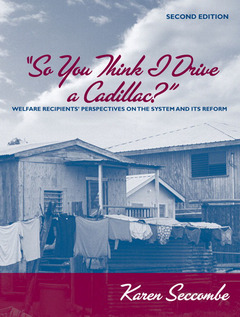Description
So you think i drive a cadillac?, welfare recipients' perspectives on the system and its reform (2nd ed )
Author: SECCOMBE Karen
Language: English
Approximative price 49.51 €
Subject to availability at the publisher.
Add to cart264 p. · Paperback
Description
/li>Contents
/li>
This down-to-earth look at the welfare system provides readers with stories from welfare recipients themselves and from those who recently left welfare for work: how they got onto welfare, what the reality of welfare (and welfare reform) is for them, issues in raising their families, their plans, hopes, and dreams are for the future, and some of the struggles they face as they try to leave the welfare system.
Welfare recipients who were interviewed by the author in Florida and Oregon share their perspectives on work requirements, family caps, time limits, and other features of the new welfare reform (TANF) program. They discuss the importance of a livable wage and health insurance in providing the needed security to leave welfare for good. These qualitative interviews are theoretically grounded, and supplemented with up-to-date statewide and national data on welfare reform and its consequences.
The author says, 'Underneath the political rhetoric and welfare statistics are real live human beings who are trying to make sense out of their lives.' Their voices provide a crucial counterpoint to the politicians and policy 'experts' who have shaped the policy reform initiative. They show us that the so-called welfare problem is related to the insecurity of low-tier work in the United States.
Preface.
Acknowledgments.
1.Introduction: Putting a Face on Welfare.
Critical and Feminist Frameworks.
Specific Contributions of This Study of Lived Experience.
Welfare and Public Policy.
Where Are the Voices of Welfare Recipients in the Discussion?
A National Profile of Welfare Recipients.
Who Are the Participants in This Study?
Conclusion and Organization.
2.Historical and Persisting Dilemmas: How Do We Explain Poverty, What Should We Do about It?
History of Cash Assistance.
Recent Attempts at Welfare Reform.
Explanations of Poverty and Welfare Use.
3.Stigma and Discrimination.
Awareness of Societal Attitudes Toward Welfare Recipients.
Managing Stigma.
4.Why Welfare?
The Influence of Social Structure.
Fatalism.
Why the Inconsistency between Explanations of Their Own and Others' Use of Welfare.
5.Day to Day Living and Decision Making.
Daily Activities: Wild Living or Depressing Routine?
Making Ends Meet with 'The Check.'
Living and Surviving on Food Stamps.
Juggling Bills.
Coping with the Stress.
Affording Life's Luxuries.
Supplementing Welfare.
6.Living and Surviving Welfare: The Importance of Family, Friends, and Formal Support.
Informal Social Support: Families, Friends, Neighbors, and Children's Fathers.
Formal Support: Help from Charities and Social Services.
Working Side Jobs: Is This Fraud?
7.Insiders' Perspectives on the Welfare System.
Florida WAGES: A Case Example.
The Role of the Government.
Opinions of the Welfare System.
Welfare Reforms.
Ideas for Reform.
8.Getting Off of Welfare.
The Women in the Middle: Why Increasing Human Capital Is Not the Only Answer.
The Importance of Our Social Structure.
9.Conclusion: Lessons Learned and Visions of Change.
The Gendered Nature of Welfare and Welfare Reform.
Has Welfare Reform Been a Success or Failure.
Insights from Other Countries.
Websites of Interest.
Bibliography.




